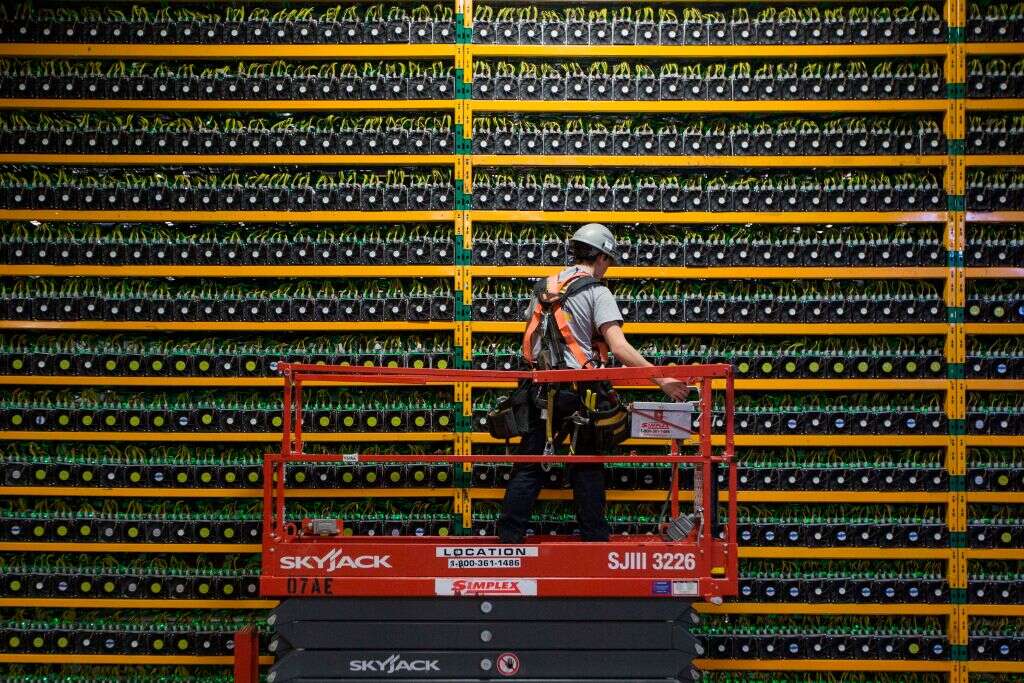
The sound is spreading across Britain. You can hear it emanating from spare bedrooms and outbuildings, low-slung warehouses and shipping containers dropped like dominos at the end of set-aside fields. It is high-pitched and steady, the tell-tale whine of hundreds of GPU fans, fighting to keep their mining rigs cool and guarantee a passive income for their owners.
Designed to mine Ethereum and other, smaller cryptocurrencies, many of these rigs are supplied by Joshua Riddett. His business, Easy Crypto Hunter, markets itself as the premier provider of altcoin mining rigs in the UK. Riddett’s client base started as a solid base of property investors and high net-worth individuals wanting to dabble in crypto, but recently that has expanded out into renewable energy operators.
“That’s actually where I’m off to today,” says Riddett, about to set off on a long drive from Manchester to a solar power plant near Teesside. While many of Easy Crypto Hunter’s customers simply plug their rigs directly into the grid, an increasing number rely on cheaper, greener power. “We’re on 42 renewable energy sites as of today,” says Riddett, with rigs hooked up to not only solar, and wind and hydropower solutions, but also anaerobic digestion plants built by farmers looking to diversify their holdings.

Riddett sees crypto mining as a new funding model for renewable power generation. Government subsidies for new sites have dried up, he says, and hardly anyone will be driven to build more if they can’t make money from them. The prospect of running mining rigs off them will meet that need, spur the construction of more renewable energy sites, and help save the planet – and perhaps the financial system, too – in the bargain. “Obviously that’s just a net positive for everybody involved,” says Riddett.
Like most in the space, Riddett believes that mining can and will become carbon neutral. That view is seemingly at odds with the model on which most cryptocurrencies operate, known as ‘proof of work’. In this model, new coins are minted by conducting highly complex calculations which require large amounts of electricity. This is especially true of the leading cryptocurrency, Bitcoin, whose total consumption needs are regularly compared to that of nations such as Belgium or Bangladesh.
Bitcoin and the environment
Crypto proponents argue that, driven by the need for cheap electricity, mining is largely powered by renewable sources, such as (until recently) the excess power generated from renewable hydroelectric dams in China. The Bitcoin Mining Council claims that roughly 56% of all Bitcoin mining is powered by renewable sources.
It is a figure that critics find hard to believe. That assessment, they say, relies on a mixture of unreliable surveys of the mining community and good-faith guesswork, and stands at odds with academic assessments that estimate Bitcoin and the total hashing economy’s reliance on renewables at 29% and 39% respectively. It also ignores the impact mining has on displacing other users from using renewable power, says author and crypto sceptic David Gerard. If “you push all these previous users of the renewables onto dirty electricity, you’ve had no effect,” he says.
Riddett says Easy Crypto Hunter doesn’t mine Bitcoin, less for its impact on the environment than its poor return on investment. But those qualms are propelling others to develop alternative models of crypto mining that consume less power. Ultimately, though, the environmental burden that society is prepared to bear from cryptocurrencies will depend on the value they are perceived to contribute – a highly contentious matter.
Jason Deane has his own mining operation, one that’s substantially larger than anything you might encounter on an English farm. “I now have a big bunch of ASICs sitting in Siberia contributing to the Bitcoin network,” explains the cryptocurrency consultant. Otherwise known as application-specific integrated circuits, these custom chips are ideal for mining the cryptocurrency, but they run at high temperatures and noise levels. All the better, then, that they’re running off the excess power of an ex-Soviet dam in the middle of nowhere.
“The glorious tractor factory never got built, but the dam did,” says Deane, “so there’s a huge amount of excess power which they want to offload somewhere.” This, he argues, is the ideal model for power generation in proof-of-work operations, and one that was mirrored until very recently in the global centre of mining activity, China. Actual data confirming this energy mix, however, remains thin on the ground, with the BMC’s estimate constituting the first authoritative attempt from the mining community itself (and even then, only a slice of it) to state where it is getting its power from. Even so, Deane believes “we can expect that [estimate] to be reasonably accurate”.
There are reasons for doubt, concedes Deane, one being “that this is self-reported”. Another is the great difficulty in measuring the impact of externalities, particularly in China. Excess power from hydroelectric dams, for example, is not guaranteed all year round. Before the recent government crackdown on Bitcoin, miners would move their operations during the dry season towards Xinjiang and its coal-burning power plants. “All of that has stopped now,” says Deane. Afraid of a shadow economy taking place beyond its control, the government has forced miners to shut down and scatter.
Eventually, these miners will relocate. In the meantime, says Deane, more and more promising power prospects for operations are emerging, not only in a rising number of renewable and nuclear installations but other applications, like using stranded natural gas from oil installations that would otherwise be flared.
This is all too hopeful for Gerard. None of these arguments, he says, factor in the impact mining operations have in displacing people from access to renewable energy. “We saw this in…upstate New York [and] the Pacific Northwest, where there were large hydro dams,” he explains. “They’d use all the cheap electricity, and the local people were pushed onto the dirty electricity from outside it at twice the price.”
In the end, says Gerard, miners are ideologically driven by their fervour for decentralised finance into a parasitical scramble for cheap electricity, no matter where it comes from. “That’s how Bitcoin mining works,” says the author. “It’s proof of waste.”
Chia: seeds of potential
Gene Hoffman agrees – to an extent. Proof of work, he says, was Bitcoin’s original sin. That flaw, however, has been corrected in Chia, a cryptocurrency that relies on so-called ‘proof of time and space’ to generate its new coins. Using hard drives and SSDs to mine instead of GPUs and ASICs, says the president of the Chia Network, will help to usher in all the benefits of a secure, decentralised financial system without the exorbitant energy usage. Mining Chia is “somewhere between 300 to 1,000 times more efficient for the same unit of security” than Bitcoin, says Hoffman.
There have been side-effects. “They’ve trashed the hard disk market,” says Gerard, who has publicly accused Chia of not only spurring rapid increases in the price of hard drives and SSDs after its initial introduction, but incentivising them to run the equipment so hard that it becomes depleted long before its normal shelf life and adding to the world’s growing pile of e-waste.
Hoffman concedes that Chia’s introduction did warp supply chains, a situation that was exacerbated by the global chip shortage and a series of major corporate buy-ups of stock. But the early destruction of SSDs is ultimately down to the quality of equipment miners chose to buy, he argues (“If you bought the $100, and not the $99, you’d never destroy it.”) Since then, Hoffman says, prices have stabilised and more recyclable hard drives are entering the marketplace.
As for the accusations that Chia’s invention is just another way for miners to consume electricity that would otherwise be used elsewhere, Hoffman makes no apology. Ultimately, this discounts the inherent benefits that crypto can and will bring to the economy. Besides, all green technologies come with costs. “One of the concerns I have when people [say], ‘This isn’t green’ is, compared to what?” says Hoffman. An electric car, for example, has more utility than a bicycle, but takes more energy to make. The banking sector’s use of hard drives dwarfs that of Chia, he adds, but the cryptocurrency’s environmental credentials are “being compared to some theoretical zero.”
Proof of stake: the future of Ethereum
There is a third model of crypto mining that uses far less energy than either Bitcoin or Chia. So-called ‘Proof of stake’ involves rewarding randomly chosen coin holders for verifying transactions on the network. To guard against their abusing this position, participants are required to ‘stake’ their own assets as security.
Several coins already run on proof-of-stake models, including Cardano, Algorand and Celo. The second-largest cryptocurrency, Ethereum, has long trailed its own switch from ‘proof of work’ to this model. Last month, founder Vitalik Buterin announced that the cryptocurrency would finally complete this task in 2022. Crucially, proof-of-stake protocols don’t require hundreds of mining rigs to run. Instead, all you need is a laptop.
This move is crucial if crypto is to achieve its potential, argues Zaki Manian, co-founder of blockchain start-up iqlusion. “Bitcoin doesn’t do all that much,” Manian says, besides providing a novel investment asset. Ethereum, by contrast, has fuelled the creation of an ecosystem of DeFi projects. Supporters argue that the network is fast becoming the future of crypto.
But if this innovation is to continue, says Manian, Ethereum must retreat from proof of work – and fast. As transactions grow larger, so do the so-called ‘gas fees’ miners earn for using their GPUs to execute them. What’s more, “proof of work has no notion of finality,” says Manian. Any sophisticated financial system can only work if there are protections to make transactions immutable, protections that can be made stronger in proof of stake networks. “This is what has motivated the shift to proof of stake far more than the energy concerns,” says Manian.
But while its environmental credentials are strong, proof of stake faces a significant cultural block within the crypto community: the appointment of individual validators, critics argue, creates the kind of oligarchy of stakeholders that crypto was invented to eliminate. “The big thing about proof of stake is it means that whoever is the largest holder [of coins], they get all the fresh coins,” explains Gerard. In Ethereum’s case, qualified validators will have to hold 32 ETH, roughly equivalent to £45,000 at the time of writing.
Nevertheless, from an environmental standpoint at least, Gerard would be glad if Ethereum could pull off the switch. The only problem is the enormous technical challenges involved in making it happen, which is why “proof of stake has been 18 months away since 2014.”

What are cryptocurrencies worth?
Until that happens – and until more reliable data is acquired on when, where and how mining consumes electricity – the debate around crypto’s environmental future will remain nebulous. For many, the discussion has been defined by the personal prejudices of its participants from the very start: whether or not you believe that mining Bitcoin, Chia or Ethereum can ever contribute any value to society.
“I think the biggest problem in the whole industry is just a lack of education across the board,” says Riddett. “If you ask the average person in the street what the fractional reserve banking system is, you’ll see nothing but a glazed look on their face. So, if you don’t understand the current system that we have, you can’t objectively analyse the problems of that system, and you can’t then realise the advantages that come from alternative systems.”
The fact remains, however, that these benefits have yet to be realised across society at large. Although trillions of dollars are now tied up in it, the prevailing mainstream narrative about crypto is one where growth is tied to speculating bubbles. Until those wider benefits of decentralised finance emerge, and more reliable data emerges on its electricity usage, the energy debate around mining will remain a giant exposed flank for crypto’s reputation and, in time, its legal standing.






